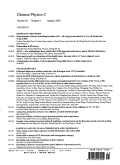- 钛学术文献服务平台 \
- 学术期刊 \
- 基础科学期刊 \
- 物理学期刊 \
- 中国物理C(英文版)期刊 \
Fusion of spherical-octupole pairs of colliding nuclei for compact and elongated configurations
Fusion of spherical-octupole pairs of colliding nuclei for compact and elongated configurations
基本信息来源于合作网站,原文需代理用户跳转至来源网站获取
摘要:
The deformation and associated optimum/uniquely fixed orientations play an important role in the syn-thesis of compound nuclei via cold and hot fusion reactions,respectively,at the lowest and highest barrier energies.The choice of optimum orientation (θopt) for the 'cold or elongated'and 'hot or compact'fusion configurations of quadrupole (β2) deformed nuclei depends only on the +/-signs of β2-deformation[J.Phys.G:Nucl.Part.Phys.31,631-644 (2005)].In our recent study[Phys.Rev.C 101,051601(R) 2020],we proposed a new set of θopt (different from the values reported for quadrupole deformed nuclei) after the inclusion of octupole deformation (up to β3) ef-fects.Using the respective θopt of β3-deformed nuclei for cold and hot optimum orientations,we analyzed the im-pact of the soft-and rigid-pear shapes of octupole deformed nuclei on the fusion barrier characteristics (barrier height VB and barrier position RB).This analysis is applied to approximately 200 spherical-plus-β3 deformed nucle-ar partners,that is,16O,48Ca+octupole deformed nuclei.Compared with the compact configuration,the elongated fu-sion configuration has a relatively larger impact on the fusion barrier and cross-sections owing to the inclusion of de-formations up to β3.Its agreement with available experimental data for the 16O+150Sm reaction (322=0.205,332=-0.055) also improves when the optimum orientation degree of freedom is fixed in view of octupole deformations.This reinforces the fact that nuclear structure effects play an important role in the nuclear fusion process.Thus,octu-pole deformed nuclei can be used for the synthesis of heavy and superheavy nuclei.

推荐文章
Hilbert空间中K-fusion框架的稳定性
算子
Hilbert空间
K-fusion框架
fusion框架
基于Compact PCI总线的数据采集系统设计
Compact PCI
数据采集
DSP
In-Fusion克隆技术构建HBVX基因真核表达质粒
乙型肝炎病毒
HBVX基因
基因克隆
表达载体
真核表达
Compact PCI热插拔技术的研究及其实现
CPCI总线
热插拔
工业总线
内容分析
关键词云
关键词热度
相关文献总数
(/次)
(/年)
文献信息
| 篇名 | Fusion of spherical-octupole pairs of colliding nuclei for compact and elongated configurations | ||
| 来源期刊 | 中国物理C(英文版) | 学科 | |
| 关键词 | |||
| 年,卷(期) | 2022,(1) | 所属期刊栏目 | NUCLEAR PHYSICS |
| 研究方向 | 页码范围 | 146-156 | |
| 页数 | 11页 | 分类号 | |
| 字数 | 语种 | 英文 | |
| DOI | 10.1088/1674-1137/ac2ed2 | ||
五维指标
引文网络
引文网络
二级参考文献 (0)
共引文献 (0)
参考文献 (0)
节点文献
引证文献 (0)
同被引文献 (0)
二级引证文献 (0)
2022(0)
- 参考文献(0)
- 二级参考文献(0)
- 引证文献(0)
- 二级引证文献(0)
引文网络交叉学科
相关学者/机构
期刊影响力
中国物理C(英文版)
主办单位:
中国物理学会
中国科学院高能物理研究所
中国科学院近代物理研究所
出版周期:
月刊
ISSN:
1674-1137
CN:
11-5641/O4
开本:
出版地:
北京市玉泉路19号(乙)中国科学院高能物理研究所内 北京918信箱
邮发代号:
创刊时间:
语种:
eng
出版文献量(篇)
3629
总下载数(次)
0
总被引数(次)
2764
期刊文献
相关文献
推荐文献
- 期刊分类
- 期刊(年)
- 期刊(期)
- 期刊推荐
力学
化学
地球物理学
地质学
基础科学综合
大学学报
天文学
天文学、地球科学
数学
气象学
海洋学
物理学
生物学
生物科学
自然地理学和测绘学
自然科学总论
自然科学理论与方法
资源科学
非线性科学与系统科学
中国物理C(英文版)2022
中国物理C(英文版)2021
中国物理C(英文版)2020
中国物理C(英文版)2019
中国物理C(英文版)2018
中国物理C(英文版)2017
中国物理C(英文版)2016
中国物理C(英文版)2015
中国物理C(英文版)2014
中国物理C(英文版)2013
中国物理C(英文版)2012
中国物理C(英文版)2011
中国物理C(英文版)2010
中国物理C(英文版)2009
中国物理C(英文版)2008

 免费查重
免费查重










